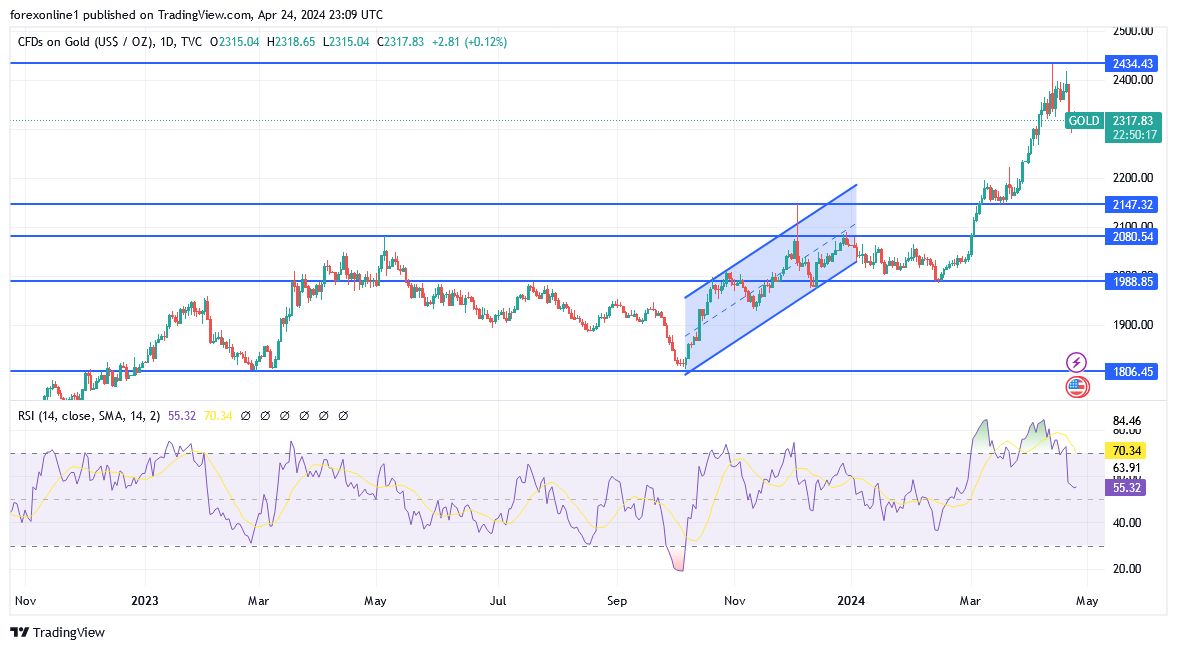- Gold prices pared losses after weaker-than-expected US business activity data helped bolster the case for Fed rate cuts this year.
- Yesterday, Gold prices rose back to around $2337 an ounce before settling around $2315 an ounce at the time of writing.
- The recent sell-off has seen gold prices test support around $2291 an ounce.
According to the results of the Economic Calendar data, commercial activity in the United States of America expanded in April at the slowest pace this year due to a decline in demand that led to the first decline in employment since 2020. The Standard & Poor’s Global Composite Index for April showed the composite index of production at... Manufacturers and service providers’ first contraction in six months. The weaker report supports the case for lower interest rates, which would support non-interest-bearing gold.
Also, according to trading the bond yields and the US dollar declined after the data results, which led to a rise in bullion prices for a short period before giving up the gains. Earlier Tuesday, gold fell as much as 1.5% to below $2,300 amid easing risks of war in the Middle East. Commenting on the recent performance of the gold market. “There will likely be some tactical short selling, given the recent rise in gold prices,” Richard Grace, senior currency, and gold strategist at ITC Markets, said in a note.
Now, traders are turning their attention to US economic data due this week, including the Fed's preferred measure of inflation, which may give further clues to the path of monetary policy.
According to the platforms of gold trading companies, the price of gold is still up about 16% since mid-February, with gains supported by geopolitical risks, central bank purchases, and Chinese consumer demand. The precious metal's price rally occurred despite advances in the dollar and Treasury yields amid signs that the Federal Reserve may delay its long-awaited pivot.
Top Forex Brokers
The question now is: How long will gold’s rise continue?
On a monthly basis, the Global Precious Metals Index (Monthly Metals Index) rose by 8.25%. However, shortly after April 1, prices of precious metals, especially gold and silver, began to rise as investors flocked to buy as much gold bullion as possible. Reasons for the newfound “gold rush” include inflation hedging, anticipation of interest rate cuts, and geopolitical uncertainty. In fact, these factors continue to push investors towards the classic safe haven of precious metals. But how long will this rise last?
The palladium price remains within the trading range...
The palladium price failed to reach price levels when testing previous significant resistance levels, including its highest levels since December 2023. Although the price rose slightly, it did not break out of the range or trend to indicate any strong upward momentum. Moreover, the current trend is within range, volatility is likely to continue amid ongoing global tensions.
Unlike other precious metals, platinum prices have not reached new highs. Although the price saw upward momentum at the end of the first quarter into the second quarter, it did not break out of its range and create the important new highs needed to signal a reversal. As with other precious metal prices, current global tensions may increase volatility.
According to the prices of other metals. Silver prices have witnessed strong upward momentum in the recent monthly price movement. Silver's volatility usually increases alongside geopolitical tensions. With the price breaching the highs in 2023, a potential test of the highs in February 2021 seems likely. As with gold, silver prices continue to form higher lows and higher highs, indicating a strong uptrend. However, volatility remains a major concern.
Returning to gold prices. In recent weeks, gold prices have broken new highs and created a new range. As prices continue to form higher lows due to rising geopolitical tensions and conflicts around the world, market participants may expect a rise in volatility. With prices surpassing 2020 levels amid bullish momentum, the uptrend remains likely to continue.
Another factor affecting the gold market, the yield on 10-year US Treasury bonds rose to 4.65%, approaching the five-month high of 4.66% seen earlier in the week, as traders digested key economic data and adjusted their expectations for price cuts. US interest rates by the Federal Reserve. Durable goods orders rose more than expected in March, led by new cars and passenger aircraft, but outside of the transportation sector, orders barely rose.
S&P's global PMIs released on Tuesday pointed to a surprising slowdown in private sector activity, with the manufacturing PMI falling to its lowest level in four months.
The focus is now on advanced GDP growth estimates and personal consumption expenditures inflation data, ahead of the US Federal Reserve's upcoming monetary policy decision next week. Most investors expect the first US interest rate cut to take place in September. A successful $69 billion auction of two-year bonds indicated strong investor demand, with additional sales of five- and seven-year bonds to follow. It will be announced this week by the Treasury Department.
Gold Price Forecast and Analysis Today:
According to the performance on the daily chart above, the price of gold is still in a downward correction range, and the recent stability confirms that both bears and bulls are in a waiting mode to obtain strength factors to move in one of the two directions. Until now, we still prefer to buy gold from every falling level, as global geopolitical tensions have not ended, and global central banks’ purchases of gold are at record levels. Currently, the closest support levels for gold are $2265 and $2190, respectively. Clearly, confidence will return to the bulls again if the price of gold returns to stability above the resistance of $2,360 per ounce again.
Ready to trade our Gold price forecast? We’ve made a list of the best Gold trading platforms worth trading with.

